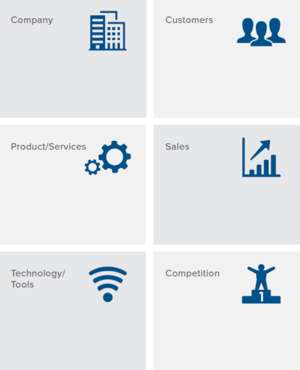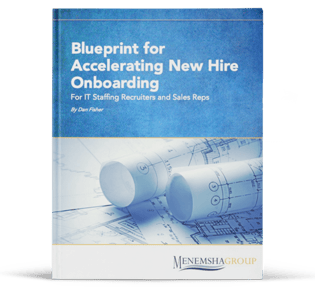Blueprint for Accelerating New Hire Onboarding
For IT Staffing Recruiters and Sales Reps

-
Table of Contents
- Introduction
- Step One: Give Your New Hires a Roadmap
- Step Two: Organize Your Training Content
- Step Three: Sequence Your Training Into Phases
- New Hire Onboarding & Training ROI
- Step Four: Deploy Your Training Content on a Web-Based Training Platform
- Step Five: Track & Measure Learner Adoption, Comprehension
- Step Six: Develop Your Onboarding Content
Introduction
As a staffing leader, getting new recruiters and reps up to speed quickly is one of your most important jobs. The sooner they’re able to make quota, the better. Yet the reality is, most recruiters and sales reps struggle to achieve proficiency in their new position and many never make it.
 The impact of this churn is costly. Brad Smart, author of Topgrading for Sales, states that the average cost of a failed ramp-up is six times the base salary for a salesperson. Despite those staggering numbers, staffing companies traditionally have taken the “water through the firehose” approach to onboarding.
The impact of this churn is costly. Brad Smart, author of Topgrading for Sales, states that the average cost of a failed ramp-up is six times the base salary for a salesperson. Despite those staggering numbers, staffing companies traditionally have taken the “water through the firehose” approach to onboarding.
Conventional thinking is, the faster we can push everyone through training, the faster we can get them out in the field selling and recruiting.
The problem, however, is there is a lot a recruiter and a salesperson must learn before they can be considered fully ramped up and “sales ready” or “recruiting ready.”
There is customer and candidate knowledge, sales and recruiting process knowledge, CRM/ATS training, company history and service offering knowledge, and pricing and capabilities.
That right there is a lot of information to retain, and we haven’t even touched on skills training, the actual skills and techniques a new hire needs to develop in order to be successful. There is just too much information to absorb all at once.
When employers try to cram too much information in too short of a time period into their onboarding, they actually make it harder and slower for new hires to become competent and productive.
Unlike many corporate training programs, the goal to effectively onboarding a new sales rep or recruiter isn’t just to make sure employees complete their training, but to ensure that they’ve mastered it.
Helping recruiters and sales reps retain information quickly and validating that they can execute those skills in the field is the ideal scenario for staffing and training leaders. But it requires planning.
We offer a blueprint for optimizing recruiter and sales onboarding for IT staffing professionals, broken down into 6 steps including details on how technology can support and sustain your program.
New recruiters and salespeople need to know specifically what they have to learn and in what sequence. Even experienced recruiters and salespeople need this – especially if they’re working in a new market or branch office or where they lack familiarity with your specific customers and the customer or candidate’s decision making process.
To provide your new hires with a roadmap that is relevant, we recommend that your onboarding timeline and sequence mimic your sales process (recruiting process for your recruiters).
 For example, suppose your sales cycle is 90 days from initial cold call to placement. With a three-month sales cycle, you should want your reps to be fully onboarded in three phases, with each phase lasting one month.
For example, suppose your sales cycle is 90 days from initial cold call to placement. With a three-month sales cycle, you should want your reps to be fully onboarded in three phases, with each phase lasting one month.
The first phase of your sales onboarding would incorporate all of the knowledge, skills and tools a new salesperson needs in order to successfully execute the first 1/3 of your sales or recruiting process. But don’t forget, you’re not just planning for thirty days.
To ensure your new hire succeeds, it’s essential to create an onboarding plan that accounts for the entire sales and recruiting process including all tasks and activities your sales rep or recruiter must complete and each of the candidate and customer touch points along the way.
The next step is to organize your training content by listing out the competencies your new salespeople and recruiters will need in order to be successful. Questions to consider include:
- What knowledge must your new hires possess in order to begin having intelligent conversations with prospects? Candidates?
- What skills must your new hires possess in order to begin having intelligent conversations with prospects? Candidates?
- What tools must your new hires know how to use in order to begin having intelligent conversations with prospects? Candidates?
Map out what your new salespeople will need to learn during their first day of work, what they will need to know in week 1, week 2, 30 Days, 60 Days and 90 Days, and repeat the process for a recruiter.
We recommend you organize your training content into the following buckets:
Knowledge Training
- What knowledge must a sales rep and recruiter possess about their buyer and candidate personas?
- Your target market?
- Industry trends and best practices?
- Pricing and rates?
- Competition?
- Market or industry trends?
Messaging Training
- What is the story the sales rep and recruiter are sharing?
- What is their value proposition?
- What customer/candidate success stories do they have to share?
- What questions do they ask?
- What questions should they be asking?
- What are their talk tracks and rebuttals to common objections?
Process Training
- What “things” does the sales rep and recruiter do?
- What steps must they execute and complete in your sales or recruiting process?
- What “things” must a candidate or client do in order to buy your service or chose your recruiter, and what must your employees do to compel the client or candidate to do those “things?”
- How does all of this connect with your messaging and your CRM/ATS?
- What gets documented in your CRM/ATS?
Once you’ve identified all the knowledge, messaging and process competencies required for success you will want to determine what your recruiters and salespeople “need to know” today versus what can be learned later.
 This sorting process enables you to create a timeline for learning. More importantly, it will highlight what a new recruiter or salesperson needs to learn today vs. down the road.
This sorting process enables you to create a timeline for learning. More importantly, it will highlight what a new recruiter or salesperson needs to learn today vs. down the road.
For example, it may be really important for your new hires to start meeting with prospects as soon as they possibly can but how will that training help them get candidates and prospects to return their voicemail and email messages?
As mentioned previously, you want to teach your new hires the the messaging, process and knowledge in the sequence they will need it.
Don’t put the cart before the horse; it will only overwhelm your new hire and slow the learning process. Map out what your new salespeople will need to learn during their first day of work, what they will need to know in week 1, week 2, 30 Days, 60 Days and 90 Days, and repeat the process for a recruiter.
Take it from me that this is an iterative process. Once you start using this onboarding plan, you’ll quickly discover ways to make it even better.
Now that you have your training content in buckets, you can chart a sequence of training modules for each one.
 Remember: the goal is to deliver your training so that your new hires can be productive throughout the onboarding process, rather than having to get through the entire program first before they begin selling or recruiting.
Remember: the goal is to deliver your training so that your new hires can be productive throughout the onboarding process, rather than having to get through the entire program first before they begin selling or recruiting.
So instead of training on each topic in its entirety, you can assign specific training modules from each bucket to the appropriate phase.
For example, let’s assume we have a technology and tools bucket and in that bucket is CRM/ATS training. Most CRM and ATS systems are complex, and each area within the CRM requires training. But a new recruiter or sales rep doesn’t need to know everything about the CRM/ATS in order to begin selling or recruiting.
So what do they need to learn right away?
For instance, a new sales rep needs to know how to enter leads or contacts into the CRM/ATS but they don’t need to know how to put a job order in the system or extend an assignment or manage time cards and invoicing.
At this point you’re probably thinking, “wow, this is a lot of work, what sort of ROI can and should I expect from my new hire onboarding and training program?”
 Here are a few of the key factors that you should consider when determining the ROI of your onboarding and training program:
Here are a few of the key factors that you should consider when determining the ROI of your onboarding and training program:
- Labor cost (man hours to build or enrollment costs if using third party training)
- Annual employee’s salary
- Average number of job orders attained by a first-year rep
- Average time to first placement and third placement for first year sales rep
- Average win rate % first year rep
- Average total number of placements for first year sales rep
- Average total gross profit & revenue generated first year sales rep
A recent report by Harvard Business Review found that only 37 percent of new salespeople will become consistent performers. And according to a study conducted by Training Industry.com, even after you find a good sales rep or recruiter, it is still going to take you on average 381 days to get that new hire executing at the same performance level as your tenured employees.
 Those statistics make it sound like we have a better chance of winning the lottery than successfully onboarding a new recruiter or sales rep.
Those statistics make it sound like we have a better chance of winning the lottery than successfully onboarding a new recruiter or sales rep.
So how can we mitigate our risk and turn the odds in our favor to making our new hires productive? We can and should follow the early adopters and leaders from within the academia and education industry.
As you’re probably aware, more and more educational institutions (and businesses) are adopting online learning. This is largely due to the increase in affordable and easy to use technology and rapidly growing demand for an engaging learning experience (think Millennials).
However, if your IT staffing firm has been utilizing traditional training methods (I.E. read the corporate handbook, shadow training and classroom training) than it may be daunting to even consider adopting an online training model. Below are just three advantages you will get from an online, web-based training solution.
Mobile Learning
Your employees, especially your millennials, are mobile which means they do just about everything on their phone from email, social and shopping, to banking, watching videos and posting photos. With online learning, your employees can access training material, coursework, exercises, videos and quizzes through their smartphones, tablets, and computers whenever they want from wherever they want.
Microlearning Accelerates Skill & Knowledge Mastery
Studies show that retention spans continue to recede which means long training sessions only compound the problem of keeping your new hires focused and adopting your training material.
The best approach to accelerate skills and knowledge adoption including time to productivity is to keep your training modules short and consistent. That is where adopting microlearning comes into play. Microlearning is a way of offering training in the form of manageable bite-sized content.
Instead of asking a learner to sit in a 60-minute lecture or watch a 60-minute video or shadow a top performer for a period of time, you break the training content down into small bite-size pieces in which each learning module or lesson only lasts approximately 6-10 minutes in duration or shorter. A web-based training platform is the perfect solution for enabling microlearning.
Consistency in Coaching, Results
One of the challenges with classroom, instructor led training is ensuring the same consistent material and message is delivered and received in its intended way. Deploying your training through an online learning platform ensures the material and messaging is consistent market to market and learner to learner.
Delivering your training in the same consistent format including certification exams that follow will ensure you teach your new hires to follow the exact same process and adopt the same sales and recruiting behaviors, all of which allows you to iterate. Iterating is very difficult with instructor led classroom training or shadow training.
A consistent approach will also save your manager’s time by enabling them to quickly and easily identify skill and performance gaps and provide the appropriate coaching.
You’ll also need a mechanism to assess whether or not your new recruiters and sales reps achieved the competencies necessary to be successful.
Remember, onboarding is not about time to completion, but knowledge and skills mastery.
To do that, you will need to create certification exams that incorporate a multitude of questions for testing your new hires engagement with your training material and their level of comprehension.
But you can’t stop there, because using quiz questions stop short of telling you whether or not your new hire can execute. To test whether or not your new hire can execute a critical customer or candidate conversation, you will need to create role play scenarios for your employees to practice rehearsing their conversations.
 Let’s assume that in order to “graduate” from Phase 1 of your sales new hire onboarding, your new hire needs to physically demonstrate they can lead an insightful, consultative customer conversation. To do this, the sales manager will need to create the role play scenarios and define the specific evaluation criteria that will define and determine whether or not the rep successfully executed an insightful, consultative customer conversation.
Let’s assume that in order to “graduate” from Phase 1 of your sales new hire onboarding, your new hire needs to physically demonstrate they can lead an insightful, consultative customer conversation. To do this, the sales manager will need to create the role play scenarios and define the specific evaluation criteria that will define and determine whether or not the rep successfully executed an insightful, consultative customer conversation.
Then, the rep will have to demonstrate that they can execute the task by executing a role play. With a web-based training solution, however, sales reps (and recruiters) could audio and video record themselves into their computer webcam executing such a conversation in which the recording can be made available for the manager to evaluate and review, thus automating the process.
Finally, managers need to provide both quantitative and qualitative feedback on their new hires performance. To do that, you can also audio and video record all role plays for the entire team to watch and learn from. You can use the video recordings much like you would when going on a diet by taking “before and after” videos to track improvement.
Once you’ve got steps 1 through 5 mapped out, it’s time to create your content. While content creation for all this training might seem daunting, the good news is that you aren’t starting from scratch; you now know the topics you need to cover, and when.
Download your personal copy of this eBook and learn how can you break this vicious cycle and onboard recruiters and salespeople in a way that actually works?

Next Steps
To learn how Menemsha Group leverages innovative technology and modern learning methods to accelerate new hire onboarding and make winning behaviors repeatable and scalable, download our eBook, Menemsha Group’s Sales & Recruiter Enablement Roadmap for Scalable Growth. In the eBook you will discover the tools, technologies, techniques, methodologies, content and processes we employ to help staffing and recruiting firms attain scalable, repeatable success. Download it today!



